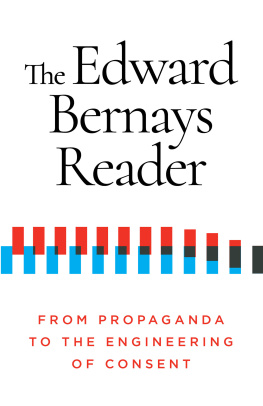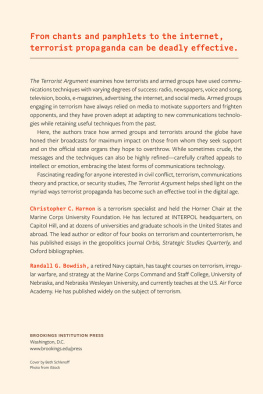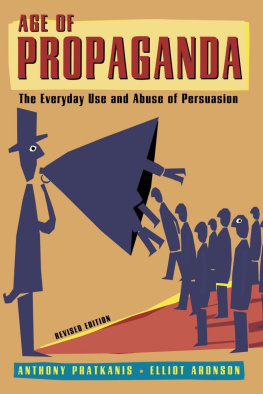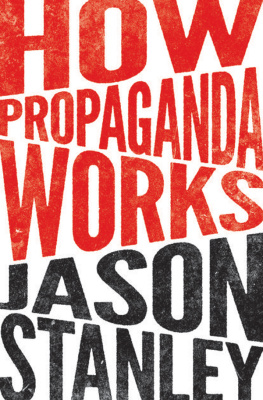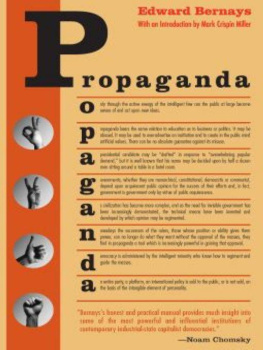TECHNIQUES OF
PROPAGANDA
& PERSUASION
Senior Editor:
Paul Moliken
Editors:
Darlene Gilmore & Sally Wein
Writer:
Magedah E. Shabo
Reviewing Teachers:
Heather Dennul
Peter Glaser
Cover and Text Design:
Maria J. Mendoza
Layout and Production:
Jeremy Clark

PRESTWICK HOUSE, INC.
Everything for the English Classroom!
2008 Copyrighted by Prestwick House, Inc.
All rights reserved. No portion may be reproduced without permission in writing from the publisher. Revised 2008.
Printed in the United States of America.
ISBN: 978-1-935466-67-3

INTRODUCTION
WHAT IS PROPAGANDA?
Have you ever had a dramatic change of heart or a strong emotional response after looking at something as simple as a billboard or a commercial? If so, you may have been looking at propaganda. It is everywhere you turn, from the newspaper to the Internet to your favorite sitcom. In fact, we are so inundated with propaganda that much of what we see and hear inevitably affects us, informing everything from the brand of shampoo we buy to our ideologies and worldviews.
In its defense, propaganda is not always harmful; in fact, in some situations it has been considered benign, or even positive. However, by its very nature, propaganda is always manipulative; it is intended to give someone else control over your thoughts and actions. For that reason, it is crucial to be able to identify propaganda when you see it.
Propaganda comes in many forms. However, with some careful study, you can recognize propaganda by its:
- persuasive function
- sizeable target audience
- representation of a specific groups agenda
- use of faulty reasoning and/or emotional appeals
In the following chapters, we will take a closer look at these criteria and paint a more detailed picture of the phenomenon we call propaganda. We will also discuss some of the most popular techniques of propaganda and their most common usesboth constructive and harmful.
By the time you have finished reading this book, you should be an informed consumer of media, well equipped to detect and analyze most of the propaganda you encounter. More importantly, as you gain practice in discerning the motives, tactics, and logic behind the messages you are exposed to, you will be empowered to make more rational, conscious decisions about how you live your life.
RECOGNIZING PROPAGANDA
Not all persuasive messages that target large audiences qualify as propaganda. In fact, even when such messages promote a specific agenda, they are often based on perfectly legitimate, soundly reasoned arguments. In propaganda, by contrast, logic is replaced with faulty reasoning, emotional appeals, or a combination of the two.
However compelling it may seem at first glance, true propaganda does not stand up to scrutiny. For example, take the following poster:

This World War I poster claims that you can save this family by contributing to the Womens Apparel Association. It also claims that if you fail to donate, you are directly responsible for the deaths of these three individuals. However, even if we assume that your contribution to the Apparel Unit really would keep an entire family alive, and not merely clothe a few individuals, there is no way to know whom your donation is reaching. The particular family in the drawing may not even exist. Hence, it is probably impossible to fulfill the guilt-inspiring command, Dont let them die. This poster is an example of propaganda that combines faulty logic with an emotional appeal.
In other cases, however, a propagandist may attempt to bypass reason altogether by exploiting emotions. By appealing to feelings, rather than logic, the propagandist can trigger automatic, instinctive responses and lead people to draw hasty and false conclusions. In a world saturated with propaganda, it is important to recognize that emotions can easily be manipulated. Feelings, therefore, should play a secondary role in most decision-making processes.
In the following image, we see an example of a strictly emotional appeal. There is no semblance of an argument; the image is simply meant to inspire fear.

These examples of propaganda both originated in the United States, during World War II. However, propaganda can still be found today, all over the world, and its very prevalence can easily lull us into a false sense of security. The same medium that convinces us to buy a certain brand of toothpaste one day may be used the next day to condone nuclear war. That is why it is important to stay alert for faulty reasoning and emotional appeals.
In the chapters that follow, we will explore some of the specific techniques propagandists use to circumvent logic, as we look at eleven of the most basic categories of propaganda. In the discussion of each form, you will find a number of examples, some historical, and others resembling messages you might see today. As you read about each form and look at the examples, try to recall where you may have seen such propaganda before, and consider the role propaganda might be playing in your daily life.
Propaganda is a persuasive and widespread message designed to represent the interests of a particular group. However, what truly sets propaganda apart from other techniques of mass communication is that it attempts to bypass logic through faulty reasoning and emotional appeals.
DISCUSSION TOPICS
These questions are intended as starting points for class discussions; for most, there is no right or wrong answer. However, all responses should be defended in a way that demonstrates an understanding of the principles of propaganda that have been discussed in this chapter.
1. What are some potential sources of propaganda in the modern world?
2. In order to qualify as propaganda, a message must meet the following criteria:
- persuasive function
- sizeable target audience
- representation of a specific groups agenda
- use of faulty reasoning and/or emotional appeals
Describe an example of a message that would meet all but one of the above criteria. Explain your answer.
3. Identify an example of propaganda you have recently been exposed to, and explain to the class why this message constitutes propaganda.

PART I: TECHNIQUES
CHAPTER 1: ASSERTION
The first, and simplest, form of propaganda is assertion. Despite being the most basic technique of propaganda, assertion is surprisingly effective. It consists of simply stating a debatable idea as a fact, with no qualification or explanation.
The Middle East will never be at peace.
A record number of hurricanes have been caused by global warming.
Assertion relies on the premise that people like to believe what they are toldthat humans are, essentially, gullible, especially when the assertion made is something they want to believe.
Next page



